Egyptian Vulture Profile
Vultures are notoriously hard to protect, and perhaps the most persecuted of bird families at the same time. Often considered vermin, they’re actually integral contributors in the cleanup crew of the ecosystem, reducing the spread of disease and helping to keep the place tidy.
Sadly, one of the smallest, the Egyptian vulture, is also one of the most affected.
The Egyptian vulture also known as the ‘white scavenger vulture’ or ‘pharaoh’s chicken’, is a small Old World vulture that is widely distributed across Southern Europe, North Africa, West Asia and India.
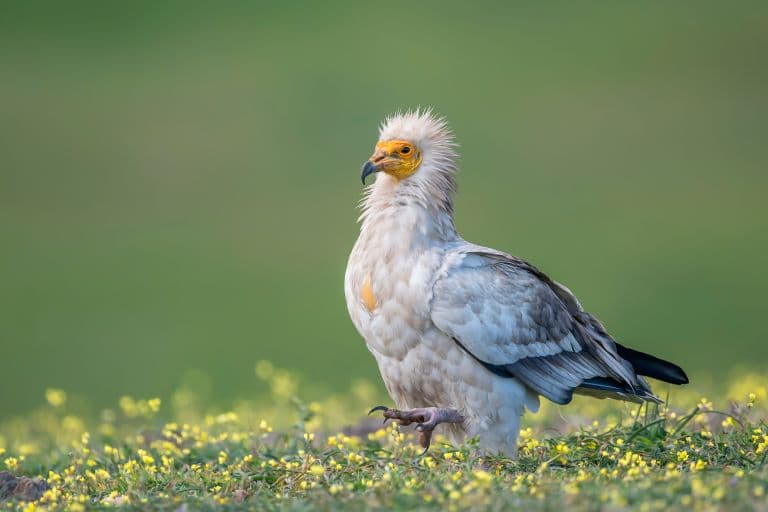
Egyptian Vulture Facts Overview
| Habitat: | Open plains, lower hills, rocky cliffs, urban areas |
| Location: | Southern Europe, northern Africa, Middle East, Asia, India, Canary Islands |
| Lifespan: | Up to 37 years in captivity, at least 21 years in the wild |
| Size: | 65cm (25 inches) long, |
| Weight: | 2.4 kg (5.3 pounds) |
| Colour: | Mostly white with black flight feathers; rusty or brownish |
| Diet: | Carrion, small mammals, birds, reptiles, eggs, insects, and sometimes vegetable matter |
| Predators: | Golden eagles, eagle owls, red foxes, jackals, and wolves |
| Top Speed: | Not listed |
| No. of Species: | 1 |
| Conservation Status: | Endangered (IUCN) |
Egyptian vultures inhabit dry plains and lower hills, and nest communally in rocky cliffs, tall trees and even on tall buildings.
There are 3 recognised subspecies of the Egyptian vulture, which vary in size, color and location. They are usually seen in pairs or singular, soaring in the thermals in search of food.
These relatively mini vultures have some excellent outside-of-the-box thinking, both in the way they eat and the way they breed.
Unfortunately, this adaptability hasn’t helped them all that much, and like many other species, they’re in serious danger from a multitude of different threats.
They’re one of only four species found in Europe, and have populations over much of the world, known to be intelligent, striking birds, who conservationists agree deserve much better.
Interesting Egyptian Vulture Facts
1. Egyptian vultures are (relatively) petite
Of the Old-World vultures, these are one of the smallest – perhaps only the marginally lighter palm-nut vulture is smaller in size.
At a maximum length of around 65cm and a wingspan of up to 170cm, they’re by no means small birds, but in the world of vultures, this isn’t going to win any fights.
They make up for their limited mass by looking awesome. A striking white plumage is flecked with spots of dark grey and contrasted against their bright yellow faces, which are surrounded by a collar of feathers.
Relatively large eyes give them an intelligent look (all vultures are highly intelligent; these ones just look the part), and a distinctly curved and slender beak makes them stand out among their peers.
These are the only birds in their genus, and one of only four species found in Europe.
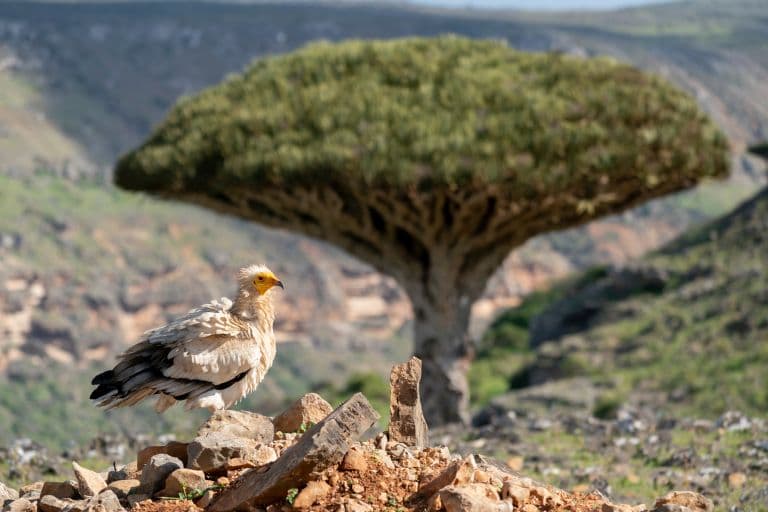
2. They defy carrion convention
When you’re the smallest, you have to figure out your own way of surviving. Egyptian vultures can’t hold their own on busy carcasses like other members of their families, but they’ve adapted a more varied diet instead.
This gives them a much greater diversity in their options for finding food. If the big antelope carcass is overcrowded with much bigger animals, they can also eat smaller mammals, bird carcasses, or even fish, insects and reptiles.
They’ve been known to eat snakes, and even predate upon eggs from other bird species. They are able to use a rock to break open ostrich and bustard eggs, and they also eat dung and even vegetable matter on occasion.
3. Egyptian vultures can cover 500 km in a day
When foraging, they can travel long distances, commonly moving over 80km each day, and 10,000km across their migratory routes between Europe and Africa.
Migrating vultures can sometimes cover 500 km (310 miles) in a day to reach the southern edge of the Sahara for winter. 1
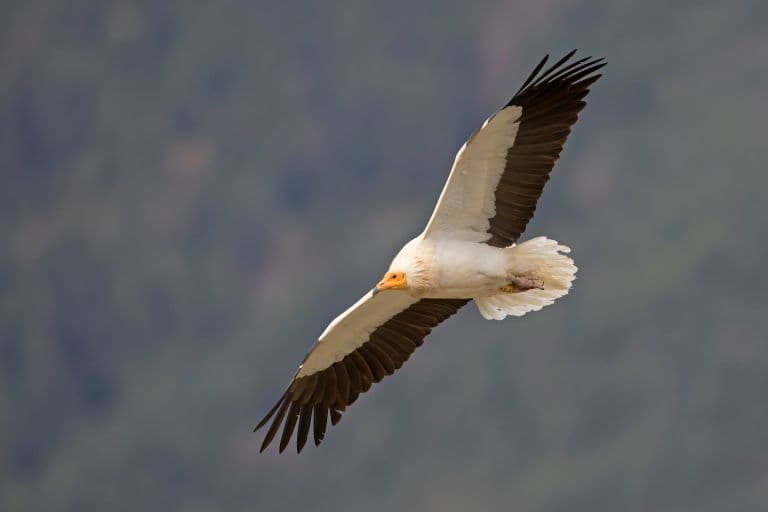
4. They’re (probably) smart!
These are so far the only vultures known to use tools and the use of tools in birds is incredibly rare.
When breaking eggs, they either throw the rock or use it like a hammer, and when building their nests, they’re known to roll up wool with a stick.
Both of these behaviours suggest intelligence but are thought to be innate behaviours – like a spider spinning a web – and not one that’s learned socially.
This means, that despite all the claims to the contrary, tool use isn’t a sign of intelligence. But! Vultures are well known for having a lot more going on behind the scenes than they let on, and this species has a history as one that can interact positively with humans.
Some, like those found in Hindo temples in India, are known to become habituated and form relationships with the monks who reside there.
5. They’re social
These birds roost in large groups, sharing trees, buildings or cliffs in communal overnighting spots. These sites are usually chosen based on their proximity to food, and at least in the Summer, the youngsters are more than welcome to join, which is said to promote the exchange of information.
Even breeding-age adults who have unsuccessfully reared young are present in these colonies, which might mean they learn from the more experienced couples during these gatherings. 2
6. They’re technically cooperative breeders
While Egyptian vultures are monogamous, they not silly enough to take on the exhausting task of child rearing on their own like some of the simpler animals.
Cooperative breeding means that it takes a bird village to rear a child, and in the spring months, enduring pair bonds are formed, and messy nests are set up.
Then, whether the other adults agree to it or not, the newly-hatched youngsters sometimes scramble between nest sites to gather scraps of food.
This vulture is one of the more adaptable of the family, and this extends to mating habits too. As such, monogamy is the guideline, rather than the rule, and isn’t followed strictly at all times. 3
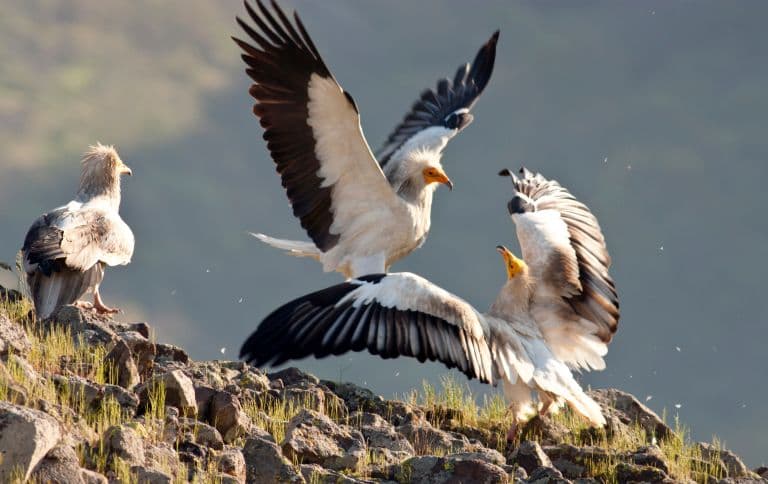
7. Egyptian vultures have a range of vocalizations
While often they are quiet birds, they can make a variety of vocalizations. They will hiss, growl and screech when angry or squabbling over a carcass!
They can also be heard making a high-pitched mewing noise and croak during flight when young.
8. They’re threatened
Vultures are some of the most damaged and at-risk birds on Earth, and sadly, the Egyptian vulture is no exception to this. The species is listed as Endangered and in decline but the IUCN, and in Europe alone has lost 50% of its population in the last three generations.
Threats include poison, power lines, hunting, and multiple other factors, exacerbated by the lack of concern for what is often considered a dirty animal and the misguided belief that they compete with farmers for livestock.
The use of medicines in said livestock can also cause a significant amount of damage to populations, with diclofenac being particularly toxic to vultures in general.
9. Conservation of the species requires multiple stakeholders
Being a highly migratory species, Egyptian vultures need protections to be on the same page at every point along their habitats. Coupled with multifaceted nature of their threats, this poses an ultimate challenge for conservationists.
Protecting nests, designing safe habitats, monitoring of breeding pairs and better designing powerline infrastructure are all focuses of protection programs. Public awareness is at the foundation of this, as farmers are one of the key threats to the species, as are policy-makers who may disregard the vulture’s safety as irrelevant.
Switching pesticides and imposing regulations on other practices like lead shot ammunition are two other efforts in place, but the complexity of the situation as a whole does not bode well for the animal.
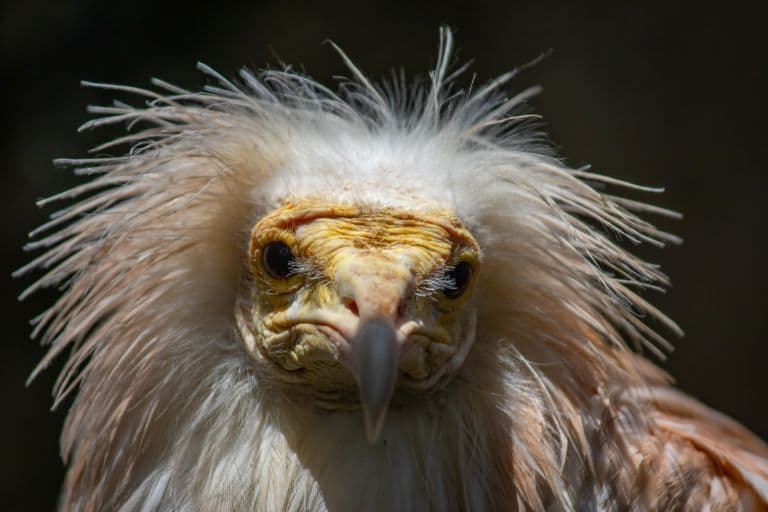
10. They are referenced in the bible
The Bible makes a reference to the Egyptian vulture under the Hebrew name of ‘rachamah/racham’, which means ‘gier-eagle’ when translated into English.
As well as the bible, several hieroglyphs include the Egyptian vulture in Ancient Egypt, and their use was a symbol of royalty and protection.
They were protected under Pharaonic law, which is where the name name ‘pharaoh’s chicken’ derived.
Egyptian Vulture Fact-File Summary
Scientific Classification
| Kingdom: | Animalia |
| Phylum: | Chordata |
| Class: | Aves |
| Order: | Accipitriformes |
| Family: | Acciptridae |
| Subfamily: | Gypaetinae |
| Genus: | Neophron |
| Species: | Neophron Percnopterus |
Fact Sources & References
- “Egyptian Vulture”, World Land Trust.
- VAN LAWICK-GOODALL (1966), “Use of Tools by the Egyptian Vulture, Neophron percnopterus”, Sci Hub.
- Sandesh Gurung (2022), “22 December 2022 Breeding Habitat and Factors Affecting the Cliff Selection by Egyptian Vultures in Central-West Nepal”, BioOne Digital Library.
